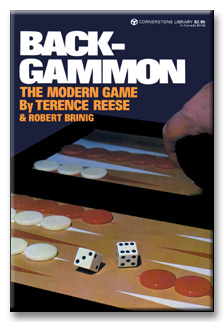
|
Backgammon Books

|
 |
|
|
|
| |
|
Backgammon The Modern Game
|
| |
|
|

|
|
AUTHORS:
|
|
Terence Reese
Robert Brinig
|
|
YEAR:
|
|
1977
|
|
PUBLISHER:
|
|
Cornerstone Library
|
|
CITY:
|
|
New York
|
|
ISBN:
|
|
0-346-12311-9
|
|
BINDING:
|
|
Softcover
|
|
PAGES:
|
|
141
|
|
SIZE:
|
|
20 cm high, 13 cm wide
|
|
NOTE:
|
|
Cover design by Charles Fellows. Photograph by John Carnevale.
|
OTHER
EDITIONS:
|
|
Hardcover, 1975
|
|
CONTENTS:
|
|
| |
|
Forward
1. Your First Half Hour: Starting the game; Throwing a double; When there is a problem in making the full legal move; Entering from the bar with two or more men; The rule for bearing off; Ways of winning; The doubling cube; Stakes and scoring; Points of procedure
2. The Opening Move: Pointers; Builders; Six-shooters; Tempters; Table of opening moves
3. Odds That Matter: What are the chances of hitting a man which is from 1 to 12 spaces away?; List of travelling shots; Effect of intervening points; Minimizing the chances of being hit; What are the chances of throwing one or more specific numbers?; Chances of entering one man from the bar; Chances of entering two men from the bar
4. The First Reply: Making a critical point; Hitting a blot; Bringing in a builder; Taking care of the back men
5. Bringing In and Bearing Off: Bearing off when there is no contact; Bearing off when there is contact; Bring in
6. Who's Ahead?: The detailed count of pips; The running check; The count by throws; The mirror method
7. Racing, Containment, and Control: Playing a running game; A blot-hitting contest; containment and control
8. Tactical Strokes in the Middle Game: Slotting; Stepping-stones; Duplicators; Reverse duplicators; Double Jeopardy; Options
9. Pacing and the Back Game: A defensive or semi-back game, as opposed to a true back game; A back game that has gone wrong; What a successful back game should look like; How to move into a back game; Don't hit until you are ready; The best points to hold in a back game
10. The Doubling Cube: How the cube is used and exchanged; The odds required for doubling, accepting, redoubling and beavering; How to judge whether you are worth a double in the early or middle game; Why it is usually right to double when you have the advantage; When you are too good to double; Doubling in the end game; The effect of playing backgammons; Some special odds when there is a closed board; "Look back in anger"
11. Tournaments, Chouettes, and the Personal Factor: Tournaments; Tactics in match play; Round Robin tournaments; Duplicate tournaments; Chouettes; The scoring and movement of players; Doubles; Stakes in a chouette; The personal factor; Playing against stronger or weaker opponents; Tactics with the doubling cube; Handicaps; Playing for money
Index
|
|
|
|
COVER:
|
|
Backgammon is a great game — easy to learn, fast, exciting, a perfect blend of chance and skill. It must possess remarkable qualities to have lasted for three thousand years. Why, then, "the modern game"? For two reasons: firstly, it has become tremendously popular; secondly, new ideas have made it almost a new game.
A number of books have analysed the opening moves, described a few specimen games and sent the reader on his way, knowing how the game is played but with little idea how to play it. Readers of Terence Reese's famous books on bridge will expect — and find — a much deeper study. The first chapter is for beginners; from then on, the reader gains an insight into the different elements of the game so that he can think for himself in all situations. The middle chapters include concepts that have always been in the mid of expert players but have never before been formulated in writing.
Mr Reese's co-author, Robert Brinig, a former lecturer in English at Berkeley University, has been a champion backgammon player for fifteen years. Together they have produced a book that will enormously increase the ability — not to mention the profit — of all who read it.
|
 |
|








